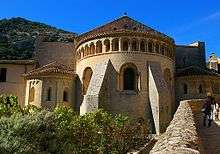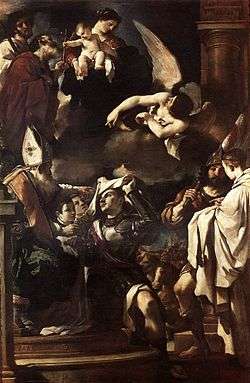William of Gellone
| Saint William of Gellone | |
|---|---|
|
William of Gellone, Guillaume d'Orange, William of Aquitaine by Guercino | |
| Born |
c. 755 somewhere in Northern France |
| Died |
28 May 812 or 28 May 814 Gellone, near Lodève? |
| Venerated in | Roman Catholic Church, Eastern Orthodox Church |
| Canonized | 1066 by Pope Alexander II |
| Major shrine | Monastery of Saint-Guilhem-le-Désert in Gellone, France |
| Feast | May 28 |

Saint William of Gellone, also known as William of Aquitaine,[1] (c. 755 – 28 May, 812 or 814 [uncertain]) was the second Count of Toulouse from 790 until his replacement in 811. His Occitan name is Guilhem, and he is known in French as Guillaume d'Orange, Guillaume Fierabrace, and the Marquis au court nez. William was canonized a saint in 1066 by Pope Alexander II.[1]
He is the hero of the Chanson de Guillaume, an early chanson de geste, and of several later sequels, which were categorized by thirteenth-century poets as the geste of Garin de Monglane. Another early product of oral traditions about William is a Latin Vita ("Biography"), written before the 11th century, according to Jean Mabillon, or during the 11th century according to the Bollandist Godfrey Henschen.
William in history
William was born in northern France in the mid-8th century. He was a cousin of Charlemagne (his mother Aldana was daughter of Charles Martel) and the son of Thierry IV, Count of Autun. As a kinsman and trusted comes, he spent his youth in the court of Charlemagne. In 788, Chorso, Count of Toulouse, was captured by the Basque Adalric, and made to swear an oath of allegiance to the Duke of Gascony, Lupus II. Upon his release Charlemagne replaced him with his Frankish cousin William (790). William in turn successfully subdued the Gascons.
In 793, Hisham I, the successor of Abd ar-Rahman I, proclaimed a holy war against the Christians to the north. He amassed an army of 100,000 men, half of which attacked the Kingdom of Asturias while the other half invaded Languedoc, penetrating as far as Narbonne.
William met this force and defeated them. He met the Muslim forces again near the river Orbieu at Villedaigne but was defeated, though his obstinate resistance exhausted the Muslim forces so much that they retreated to Spain. In 801, William commanded along with Louis King of Aquitaine a large expedition of Franks, Burgundians, Provençals, Aquitanians, Gascons (Basques) and Goths that captured Barcelona from the Moors.
In 804, he founded the monastery of Gellone (now Saint-Guilhem-le-Désert) near Lodève in the diocese of Maguelonne. He granted property to Gellone and placed the monastery under the general control of Benedict of Aniane, whose monastery was nearby.[2] Among his gifts to the abbey he founded was a piece of the True Cross, a present from his cousin Charlemagne. Charlemagne had received the relic from the Patriarch of Jerusalem according to the Vita of William.
In 806, William retired to Gellone as a monk and eventually died there[2] on 28 May 812 (or 814). When he died, it was said the bells at Orange rang on their own accord.
William mentioned both his family and monastery in his will:[3] His will of 28 January 804, names his living wives Gunegunde and Guitburgi, his deceased parents, Teuderico (Theodoric / Thierry IV) and Aldana van Martel (daughter of Charles Martel), two brothers, Teudoino and Adalelmo, two sisters, Abbana and Bertana, four sons, Barnardo, Guitcario, Gotcelmo, and Helmbruc, not his daughter (Rotlinde van Bobbio van Gellone), and one nephew, Bertrano.[4] His wife Guitburgi is said to have been the widow of the Moorish wali of Orange taken by William in his battles against the Umayyad army of Hisham I in and around the county of Narbona about 793-796. His son Barnardo is said to have been by Guitburgi. Her name before her baptism was Orable.[5] It is not clear if she married William or was held in concubinage, although he calls her his wife in his will.
Gellone remained under the control of the abbots of Aniane. It became a subject of contention however as the reputation of William grew. So many pilgrims were attracted to Gellone that his corpse was exhumed from the modest site in the narthex and given a more prominent place under the choir, to the intense dissatisfaction of the Abbey of Aniane. A number of forged documents and assertions were produced on each side that leave details of actual history doubtful. The Abbey was a major stop for pilgrims on their way to Santiago de Compostela. Its late 12th century Romanesque cloister, systematically dismantled during the French revolution, found its way to The Cloisters in New York. The Sacramentary of Gellone, dating to the late 8th century, is a famous manuscript.
William in romance
William's faithful service to Charlemagne is portrayed as an example of feudal loyalty. William's career battling Saracens is sung in epic poems in the 12th and 13th century cycle called La Geste de Garin de Monglane, some two dozen chansons de geste that actually center around William, the great-grandson of the largely legendary Garin.
One section of the cycle, however, is devoted to the feats of his father, there named Aymeri de Narbonne, who has received Narbonne as his seigniory after his return from Spain with Charlemagne. Details of the "Aymeri" of the poem are conflated with a later historic figure who was truly the viscount of Narbonne from 1108 to 1134. In the chanson he is awarded Ermengart, daughter of Didier, and sister of Boniface, king of the Lombards. Among his seven sons and five daughters (one of whom marries Louis the Pious) is William.
The defeat of the Moors at Orange was given legendary treatment in the 12th century epic La Prise d'Orange. There, he was made Count of Toulouse in the stead of the disgraced Chorso, then King of Aquitaine in 778. He is difficult to separate from the legends and poems that gave him feats of arms, lineage and titles: Guillaume Fièrebras, Guillaum au Court-Nez (broken in a battle with a giant), Guillaum de Narbonne, Guillaume d'Orange. His wife is said to have been a converted Saracen, Orable later christened Guibourc.
| Preceded by Torson |
Count of Toulouse 790–811 |
Succeeded by Beggo |
References
- 1 2 "William of Aquitaine, St.". Encyclopedia.com. Retrieved on 2014-01-17.
- 1 2 "CATHOLIC ENCYCLOPEDIA: St. William of Gellone". newadvent.org.
- ↑ http://www.fordham.edu/halsall/french/g1.htm
- ↑ "Internet History Sourcebooks Project". fordham.edu.
- ↑ http://www.midi-france.info/060600_guilhem.html
| Wikimedia Commons has media related to William of Gellone. |
- "L'Abbaye de Saint-Guilhem-le-Desert" (in French)
- Metropolitan Museum:The Saint-Guilhem Cloister
 This article incorporates text from a publication now in the public domain: Chisholm, Hugh, ed. (1911). "article name needed". Encyclopædia Britannica (11th ed.). Cambridge University Press.
This article incorporates text from a publication now in the public domain: Chisholm, Hugh, ed. (1911). "article name needed". Encyclopædia Britannica (11th ed.). Cambridge University Press.
External links
- "The saint who married a Muslim princess", Catholic Herald, January 4, 2008
- "Die altfranzösische Wilhelmsage und ihre beziehung zu Wilhelm dem Heiligen 1896"
